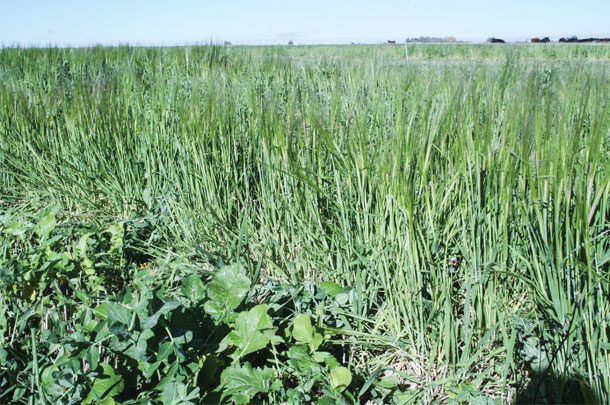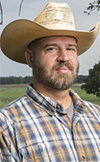This typically requires planting wheat in September to be ready to graze by some time in November. This is also an area of the country where many cows calve in the late winter, often around Valentine’s Day. Given a weaning age of 208 days, calves could be weaned in September. Frequently, these calves are fed in a lot for two months until wheat pasture is ready. Instead of being fed in a lot, these calves could be allowed to graze warm-season perennial grass pastures, but forage quantity or quality is often lacking in pastures at this time of year.
An alternative method to provide for these calves is to plant what could be called a multispecies cover crop mix on a portion of the previous year’s wheat acres after grain harvest in June. Producers in north Texas and Oklahoma have been experimenting with just such a practice for the past several years. The cover crop provides ecological benefits throughout the summer, such as shading the ground and reducing evaporation, breaking compaction with growing roots, scavenging nutrients and feeding soil biology, and reducing wind and water erosion.
Aboveground biomass on these cover crops typically reaches its maximum about 90 days after planting, just in time for calf weaning. The weaned calves can now graze this cover crop from September until wheat pasture is ready. Not only does it fill a forage gap for grazing cattle, but the grazing can sometimes even be used as the termination method for the cover crop.
One example of this is from a producer in western Oklahoma in 2018. He planted a mix of annuals such as sorghum, sudan, sorghum-sudan, pearl millet, browntop millet, foxtail millet, cowpeas, sunn hemp, soybeans, collards, okra, sunflowers and more on June 8, one day after harvesting the grain on a 56-acre, dual-purpose wheat field. On Sept. 24, he turned out 88 head of calves weighing an average of 489 pounds to begin grazing. This group of cattle was able to graze this field for 43 days until Nov. 6. At that time, their average weight was 573 pounds. During that time, they gained an average of 84 pounds per head or 1.95 pounds per head per day. Since there were 1.57 calves per acre, per-acre gain was 3.07 pounds per day.
Assuming the cost of this cover crop was $10 per acre for a portion of the rent for the year, $20 per acre for seed and $15 per acre for planting, the cost of gain was 34 cents per pound of beef produced with 132 pounds of gain produced per acre.
In addition to the fact that this producer did not have to spend time feeding these cattle in a lot, he also had cost savings on this field by not making summer chemical fallow herbicide applications, which typically cost at least $10 per acre per application.
Other benefits include all of the ecosystem services the cover crop provided during the summer, as mentioned earlier. It is hard to put a value on some things like reduced evaporation or erosion control. However, we can estimate values for things like mechanical deep ripping with tillage tools at $25 or more per acre and nitrogen fertilizer savings at 40 cents per pound x 10, 20 or more pounds per acre. Also, with good management of multispecies cover crops, we usually see earthworm numbers increase, leading to increased soil water infiltration and storage.
A slight modification to this system some producers are using is to graze cow-calf pairs on these cover crops during this same window of time. It is not uncommon for them to have 3 pounds per-head per-day gain on calves still nursing and grazing cover crop mixes with their mothers. Partway through the grazing window, the cows are pulled from the field, and the calves are left behind to continue grazing. It appears the calves wean extremely easily with this system, with no noticeable stress as they continue to graze and gain weight.
With each system, the producer can move the calves from the cover crop to the wheat pasture crop as they wish based on the availability of forage from each in November. At that time, the cover crop field can then be planted to wheat either for grain only or for spring grazeout.
An additional benefit producers in both systems report is: They have significantly less calf morbidity and mortality when grazing these mixes than when the cattle are in a lot or even on monoculture forages. ![]()
PHOTO: When grazing wheat fields in a rotation, cover crops can fill the gap with good average daily gains, soil health benefits and cost-effectiveness. Photo by Lynn Jaynes.

-
Jim Johnson
- Soils and Crops Consultant
- Noble Research Institute
- Email Jim Johnson












